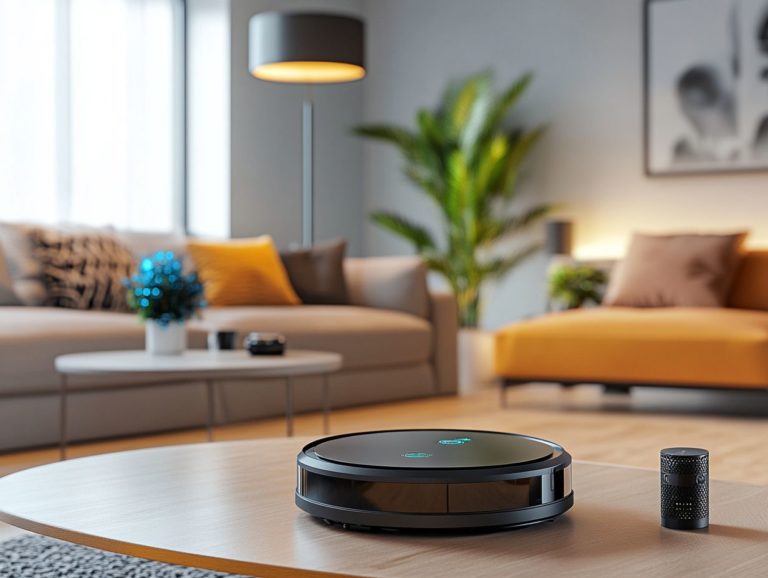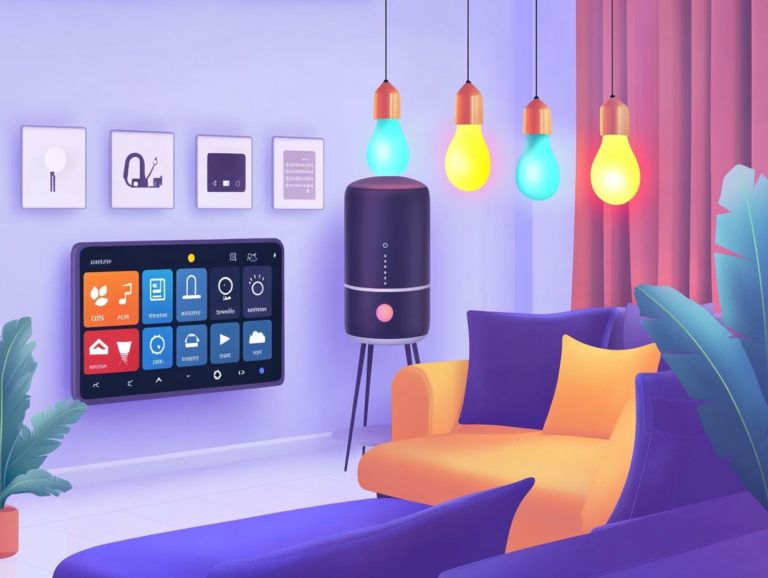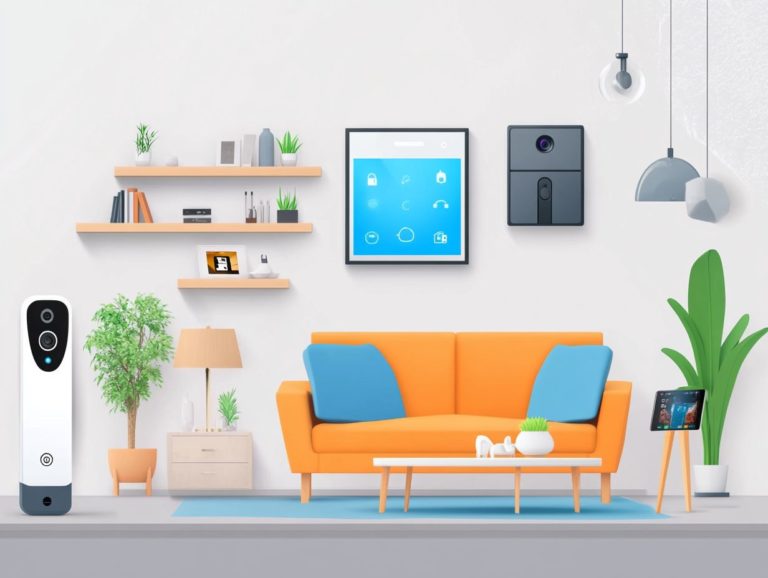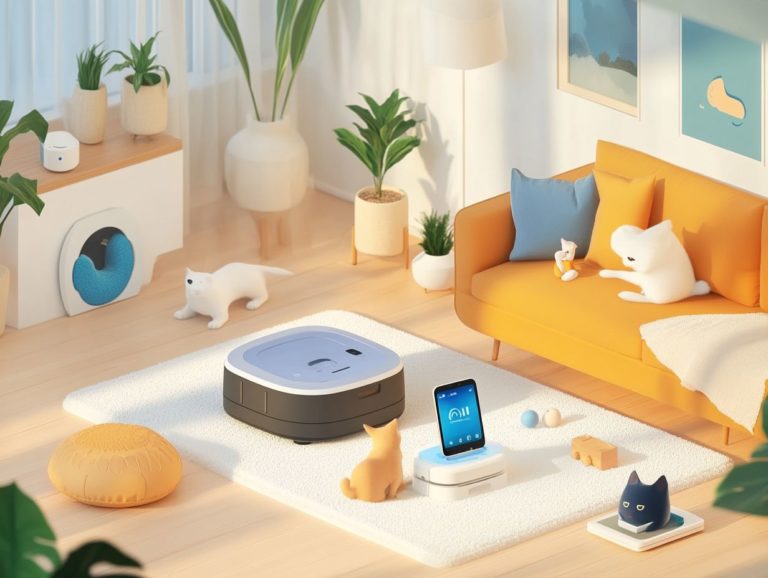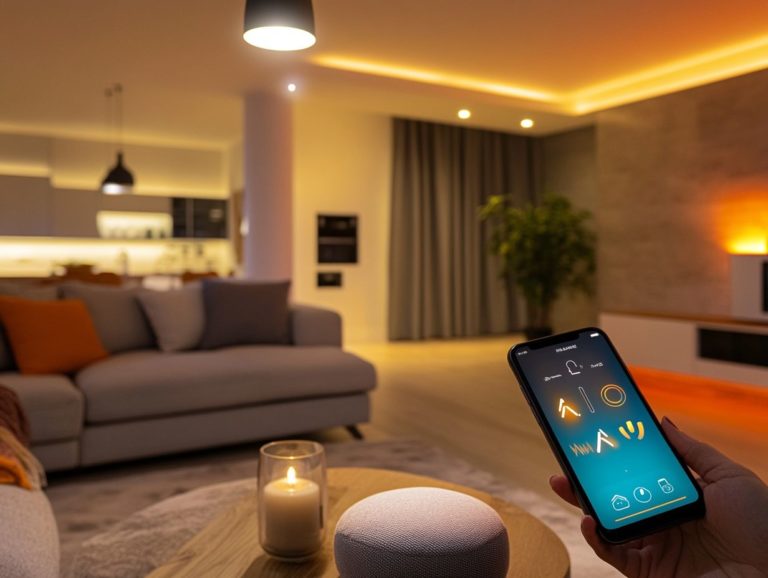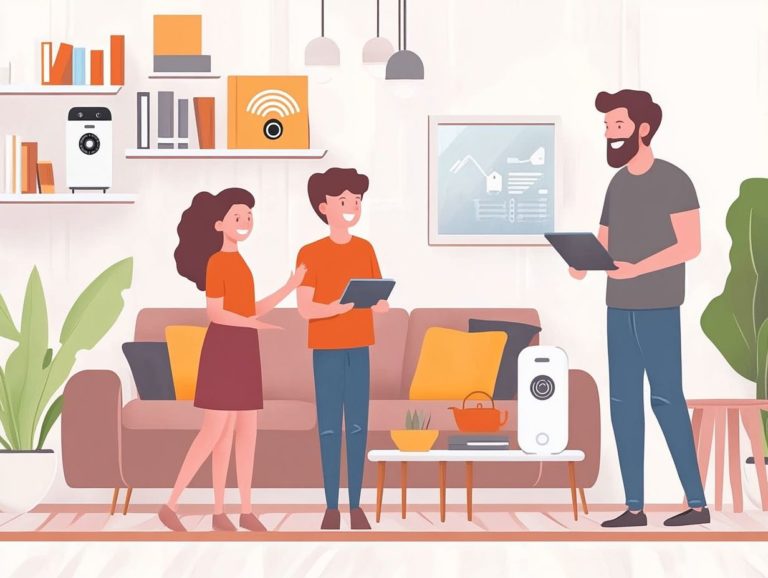Creating a Smart Home for Remote Work
In today’s fast-paced world, the idea of a smart home is revolutionizing the way you live and work especially if you re embracing remote work.
Picture a living space designed to elevate your comfort while boosting your productivity and efficiency.
This article delves into the myriad benefits of a smart home tailored for remote work, highlighting improved convenience, cost savings, and essential components such as smart lighting and security systems.
You will also find a step-by-step guide to setting up your own smart home, along with tips to unlock their full potential.
Explore how a smart home can transform your remote work experience into something truly exceptional!
Contents
- Key Takeaways:
- Benefits of a Smart Home for Remote Work
- Essential Components of a Smart Home for Remote Work
- Smart Entertainment and Communication
- Setting Up a Smart Home for Remote Work
- Step-by-Step Guide
- Maximizing the Potential of a Smart Home for Remote Work
- Frequently Asked Questions
- What is a smart home?
- How can creating a smart home benefit remote work?
- What are the essential components to create a smart home for remote work?
- Can I control my smart home for remote work from anywhere?
- Is it necessary to have technical knowledge to create a smart home for remote work?
- Are there any security risks to consider when creating a smart home for remote work?
Key Takeaways:
A smart home enhances remote work by automating tasks and creating a comfortable environment. Cost savings and convenience are other benefits, as it reduces energy usage and provides remote access to devices. Essential components include smart lighting, temperature control, security systems, and entertainment options.
What is a Smart Home?
A smart home is your personal sanctuary, equipped with connected devices that enable you to monitor and manage your living space with convenience and efficiency.
This system includes everything from Philips Hue smart lighting to Honeywell smart thermostats, allowing you to automate and control your environment through platforms like Google Assistant, Amazon Alexa, and Apple HomeKit.
This integration elevates your living standards and enhances your security. With an easy-to-use interface, you can manage daily tasks, improve energy efficiency, and establish a robust security system with ease.
These devices communicate effortlessly via Wi-Fi or other methods, allowing you to adjust lighting or monitor security cameras from anywhere.
Major industry players like Google, Amazon, and Apple have transformed the smart home landscape. Each offers compatibility with a wide range of devices and services.
For example, Google’s ecosystem works well with Nest cameras and smart displays, while Amazon’s Alexa integrates seamlessly with many third-party gadgets.
Apple’s HomeKit, known for its focus on privacy and security, offers a unique approach to device management, appealing to those who prioritize data protection.
Together, these elements create a smarter, more responsive living space that meets the needs of today s homeowners.
Benefits of a Smart Home for Remote Work
Implementing a smart home system can elevate your remote work experience by enhancing productivity, cutting energy costs, and delivering convenience through automation.
Imagine features like smart lighting that adjusts to the time of day and smart thermostats from brands like Nest or Ecobee, all working together to curate an optimal work environment.
With voice commands through smart speakers or displays, you can tackle tasks hands-free, fostering a focused workflow.
Improved Efficiency and Productivity
Integrating smart devices into your home office boosts your efficiency and productivity, allowing you to immerse yourself in your work without distractions.
Smart lighting systems adjust brightness for optimal visibility, while smart thermostats keep the climate comfortable, sparing you constant adjustments.
With smart assistants at your disposal, you can manage your schedule, set reminders, or even make calls all with a simple voice command. This hands-free operation helps keep you engaged in your tasks.
During a video conference, your smart lighting can shift to a warmer tone to enhance the visual experience, while the thermostat ensures the temperature is just right, keeping everyone comfortable and attentive.
By leveraging these technologies, your remote work environment transforms into a space that is functional, efficient, and enjoyable.
Cost Savings and Convenience
Smart homes offer convenience through automation and significant cost savings over time. This makes them an appealing choice for remote workers like you.
By using energy-efficient smart devices, you can monitor and manage your energy consumption. This leads to lower utility bills.
With advanced network security features, your personal information and devices are protected. You can ensure a safer environment for your home office.
Implementing systems like smart plugs and switches helps you track device usage. This allows you to identify energy hogs and cut down on unnecessary consumption.
Automating your heating, ventilation, and air conditioning (HVAC) system based on occupancy can lead to substantial savings during peak hours. Integrating solar power or battery storage with smart technology takes your energy management to new heights.
However, these conveniences require robust network security measures. A compromised system could lead to financial losses and privacy breaches, so investing in secure connections is essential.
Essential Components of a Smart Home for Remote Work

To build an effective smart home for remote work, incorporate several key components.
- Think smart lighting, smart thermostats, advanced security systems, and entertainment options.
Smart lighting, like Philips Hue, allows you to customize settings for different tasks. This enhances your productivity.
Smart thermostats from Honeywell or Nest maintain the perfect temperature, keeping you comfortable throughout your workday.
A strong security system creates a safe environment so you can focus without distractions. Smart entertainment devices offer great options for relaxation during breaks.
Smart Lighting and Temperature Control
Smart lighting and temperature control are vital features of a smart home, especially for remote workers. They help create an optimal work environment.
With lighting solutions like Philips Hue, you can adjust the surrounding light to match your mood. Smart thermostats from Honeywell keep your rooms at the ideal temperature, enhancing comfort and focus.
These systems are energy-efficient and integrate effortlessly with voice assistants like Google Assistant and Amazon Alexa. You can adjust settings hands-free.
Imagine programming smart bulbs to brighten gradually in the morning, mimicking a natural sunrise. Meanwhile, your smart thermostat adjusts according to your schedule.
This automation supercharges your productivity and creates a tranquil space for relaxation at the end of the day.
Smart Security and Surveillance
A smart security system gives you peace of mind as a remote worker. It includes advanced surveillance and monitoring capabilities that you can control from anywhere.
Devices like Ring offer comprehensive security solutions. You can monitor your property in real-time, receive alerts, and manage access directly from your smartphone.
Many smart security systems connect with home automation features, creating a cohesive home management approach. For example, a smart system can adjust lighting when someone approaches, simulating presence to deter intruders.
With remote monitoring, keep an eye on your home during work hours or while traveling. You can check cameras, track your space, and receive instant alerts about unusual activity. This heightens your security and lets you respond quickly if needed.
Smart Entertainment and Communication
Smart entertainment and communication solutions are essential for crafting a balanced remote working environment. They offer the perfect blend of work-related functionalities and leisure opportunities.
Devices like smart speakers and displays enable you to communicate effortlessly through voice commands. They also grant you access to music, podcasts, and video streaming transforming your breaks and downtime into truly enjoyable and refreshing experiences.
Consider brands like Amazon with their Echo devices and Google with their Nest Hub. They provide features that make quick video conferences or casual chats with colleagues a breeze, effectively reducing the isolation that often accompanies remote work.
Platforms like Spotify and Netflix integrate seamlessly into these systems. This allows you to unwind with your favorite playlists or shows.
This harmonious combination not only helps you maintain focus during work hours. It also promotes your mental well-being by encouraging regular relaxation through easily accessible entertainment options.
Setting Up a Smart Home for Remote Work
Setting up a smart home for remote work requires careful consideration of several key elements. Start by selecting the right smart devices that align with your needs.
A reliable Wi-Fi connection is essential, as it forms the foundation of your smart home. Thoughtfully configuring your automation settings will create a seamless environment that enhances both comfort and efficiency.
Incorporating components like smart switches, lighting, and security systems allows for a cohesive setup tailored specifically for you. With automation features, your devices can work in harmony, significantly boosting your convenience and productivity.
Step-by-Step Guide
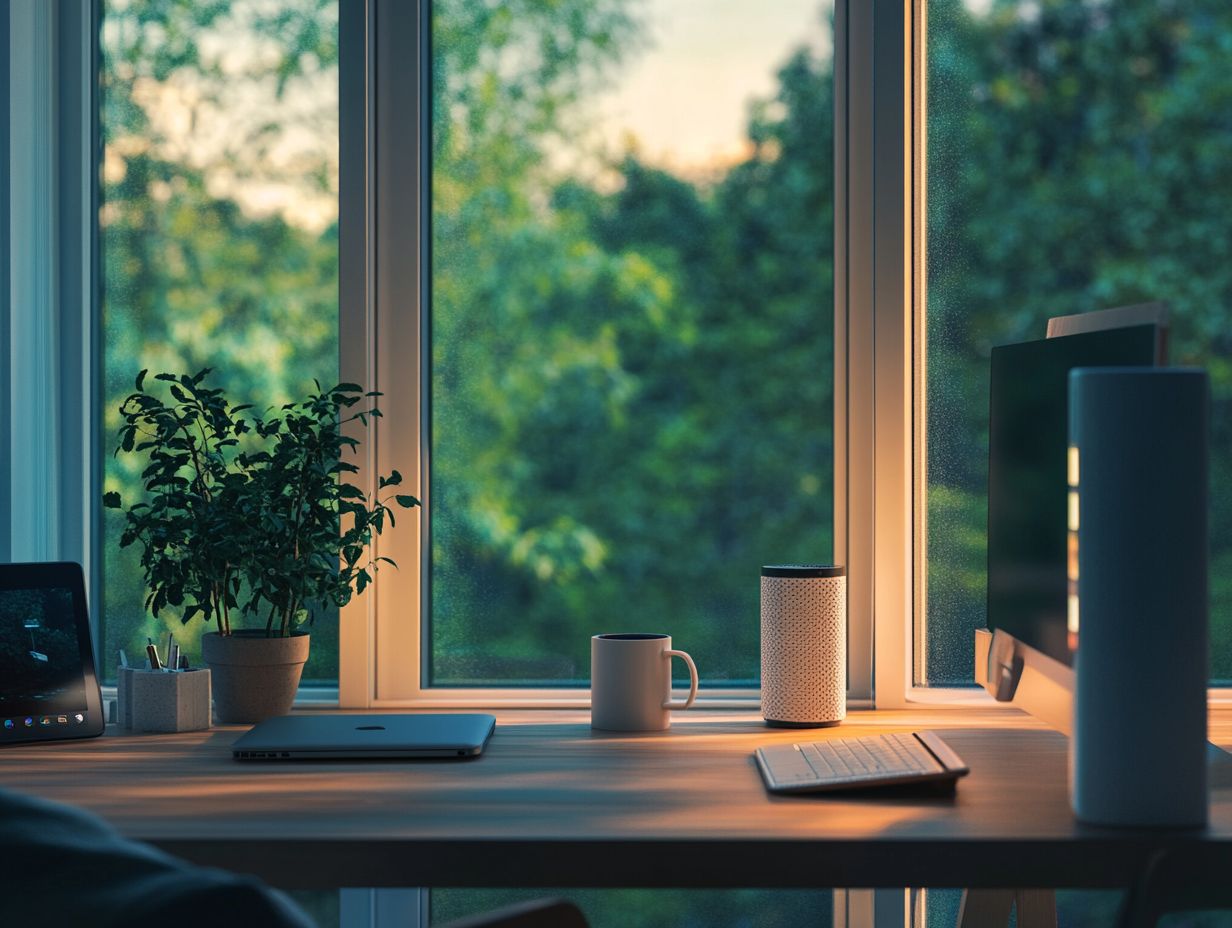
A step-by-step guide to setting up your smart home for remote work starts with choosing the right smart devices that align perfectly with your lifestyle and work requirements. Ensure that your devices communicate effectively with one another. Understanding the available automation features is key to enhancing efficiency and convenience in your work-from-home environment.
Dive into thorough research on the different smart home ecosystems available, such as Google Assistant, Amazon Alexa, and Apple HomeKit. This exploration will help you pinpoint which platform s features resonate with your preferences and workflow.
Compile a list of essential devices tailored to support your chosen ecosystem, including:
- Smart lighting
- Thermostats
- Security cameras
Once you ve identified the devices that best serve your needs, install them, ensuring each one connects seamlessly to the central hub.
Configure automation settings and routines to create a personalized experience that streamlines your daily tasks and maximizes productivity. Finally, conduct a thorough test of all devices to confirm their performance and compatibility, ensuring your integrated setup operates without a hitch.
Maximizing the Potential of a Smart Home for Remote Work
Maximizing the potential of your smart home for remote work requires seamless integration of smart devices, efficient automation, and effective use of voice commands for your daily tasks.
Optimize your device setup and fully grasp the features of smart technologies. You can craft an environment that enhances both productivity and comfort.
Don’t wait transform your workspace today for a better tomorrow! Start your journey towards a smarter, more efficient home today!
Tips and Tricks for Optimal Use
To optimize your smart home for remote work, consider implementing practical tips and tricks that enhance productivity and convenience.
Efficient automation can make a world of difference. For instance, scheduling your smart lights to adjust according to your work hours and using voice commands for hands-free control can dramatically elevate your work-from-home experience.
Integrating smart devices with platforms like IFTTT takes automation to new heights. Picture this: your coffee maker starts brewing the moment your alarm goes off! That’s the kind of morning boost you deserve.
Utilizing apps to monitor energy usage helps you save costs and encourages sustainable habits that benefit both your wallet and the planet.
If you encounter common issues, reset the device or check the app settings for troubleshooting.
Stay updated with the latest technology to keep your home efficient and adapt seamlessly to your evolving needs, ensuring you stay ahead in your remote work setup.
Frequently Asked Questions
What is a smart home?
A smart home refers to a residence that uses internet-connected devices to control things automatically, such as lighting, heating, cooling, and security.
How can creating a smart home benefit remote work?
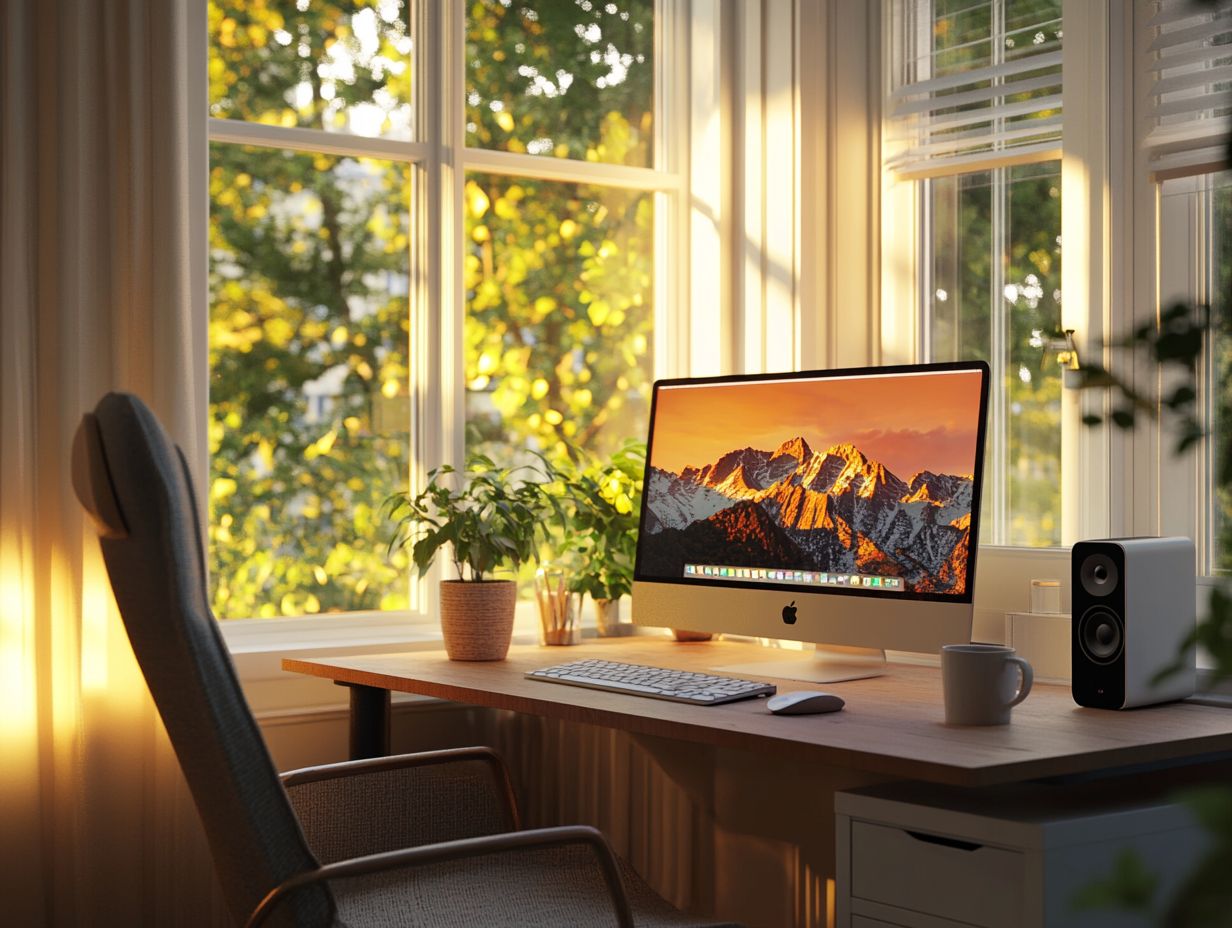
Creating a smart home can enhance remote work by providing a more efficient and convenient work environment. With the best smart home solutions for home offices, tasks like adjusting lighting and temperature can be done remotely, saving time and effort.
What are the essential components to create a smart home for remote work?
The essential components of a smart home for remote work include a reliable internet connection, smart devices such as lights, thermostats, and security systems, and a central hub to control and connect these devices.
Can I control my smart home for remote work from anywhere?
Yes, as long as you have an internet connection, you can control your smart home from anywhere. You can use a smartphone app or a web-based platform to access and manage your devices remotely.
Is it necessary to have technical knowledge to create a smart home for remote work?
No, you do not need technical knowledge to create a smart home for remote work. Most smart home devices are designed to be user-friendly and can be easily set up and controlled through a simple interface.
Are there any security risks to consider when creating a smart home for remote work?
As with any internet-connected devices, there is a potential risk of cybersecurity threats. It is essential to choose reputable and secure devices, set strong passwords, and regularly update your devices’ firmware to minimize these risks.
Start implementing these tips for an optimal smart home experience today!


